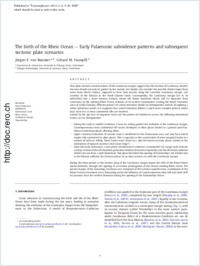The birth of the Rheic Ocean — Early Palaeozoic subsidence patterns and subsequent tectonic plate scenarios
- Raumer, Jürgen F. von Department de Géosciences, Université de Fribourg, Suisse, Switzerland
- Stampfli, Gérard M. Géologie-Paléontologie, Université de Lausanne, Suisse, Switzerland
-
22.04.2008
Published in:
- Tectonophysics. - 2008, vol. 461, no. 1-4.1, p. 9-20
English
New plate-tectonic reconstructions of the Gondwana margin suggest that the location of Gondwana-derived terranes should not only be guided by the models, but should also consider the possible detrital input from some Asian blocks (Hunia), supposed to have been located along the Cambrian Gondwana margin, and accreted in the Silurian to the North-Chinese block. Consequently, the Gondwana margin has to be subdivided into a more western domain, where the future Avalonian blocks will be separated from Gondwana by the opening Rheic Ocean, whereas in its eastern continuation, hosting the future basement areas of Central Europe, different periods of crustal extension should be distinguished. Instead of applying a rather cylindrical model, it is supposed that crustal extension follows a much more complex pattern, where local back-arcs or intra-continental rifts are involved.Guided by the age data of magmatic rocks and the pattern of subsidence curves, the following extensional events can be distinguished: – During the early to middle Cambrian, a back-arc setting guided the evolution at the Gondwana margin. Contemporaneous intra-continental rift basins developed at other places related to a general post-Pan-African extensional phase affecting Africa – Upper Cambrian formation of oceanic crust is manifested in the Chamrousse area, and may have lateral cryptic relics preserved in other places. This is regarded as the oceanisation of some marginal basins in a context of back-arc rifting. These basins were closed in a mid-Ordovician tectonic phase, related to the subduction of buoyant material (mid-ocean ridge?) – Since the Early Ordovician, a new phase of extension is observed, accompanied by a large-scale volcanic activity, erosion of the rift shoulders generated detritus (Armorican Quartzite) and the rift basins collected detrital zircons from a wide hinterland. This phase heralded the opening of Palaeotethys, but it failed due to the Silurian collision (Eo-Variscan phase) of an intra-oceanic arc with the Gondwana margin. During this time period, at the eastern wing of the Gondwana margin begins the drift of the future Hunia microcontinents, through the opening of an eastern prolongation of the already existing Rheic Ocean. The passive margin of the remaining Gondwana was composed of the Galatian superterranes, constituents of the future Variscan basement areas. Remaining under the influence of crustal extension, they will start their drift to Laurussia since the earliest Devonian during the opening of the Palaeotethys Ocean.
- Faculty
- Faculté des sciences et de médecine
- Department
- Département de Géosciences
- Language
-
- English
- Classification
- Geology
- License
-
License undefined
- Identifiers
-
- RERO DOC 10847
- DOI 10.1016/j.tecto.2008.04.012
- Persistent URL
- https://folia.unifr.ch/unifr/documents/300734
Statistics
Document views: 141
File downloads:
- pdf: 452
